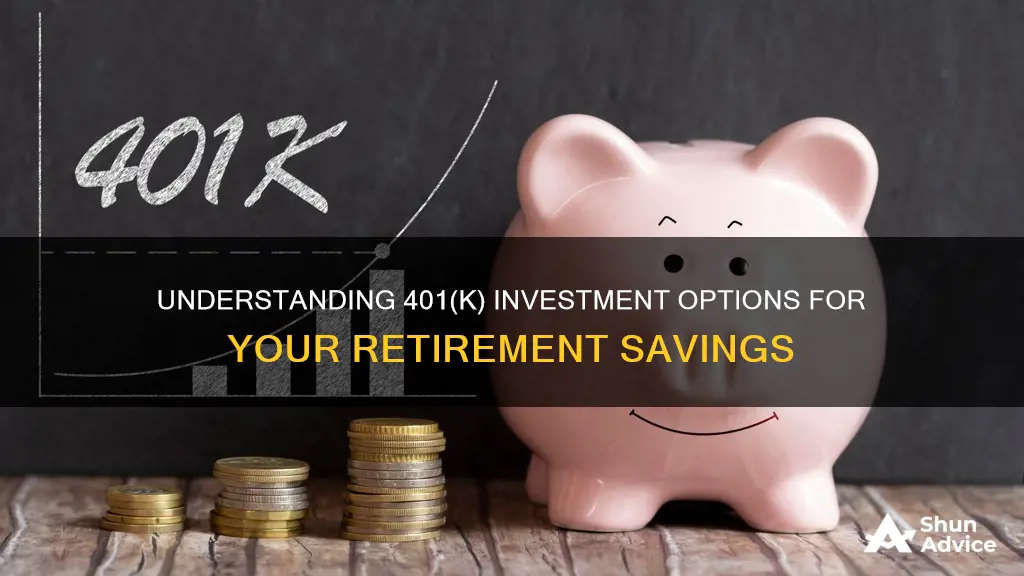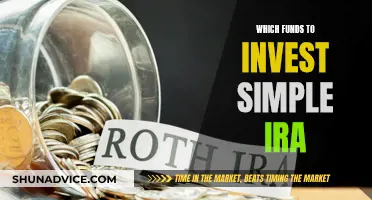
When it comes to investing your 401(k), there are a few different options to consider. The best choice for you will depend on your unique circumstances, such as your risk tolerance, financial goals, and time horizon. Here are some of the most common investment options for 401(k) plans:
- Target-date funds: These funds are managed with a focus on a specific retirement year. The fund's asset allocation becomes more conservative as the target date approaches, usually by reducing the level of stock investments and increasing investments in bonds. Target-date funds are a good choice for those who want a more hands-off approach to their 401(k) investments.
- Mutual funds: Mutual funds are the most common investment option offered in 401(k) plans. They can be actively managed or passive, and they range from conservative to aggressive in terms of risk. Mutual funds may invest in stocks, bonds, or a mix of both.
- Exchange-traded funds (ETFs): ETFs are similar to mutual funds but are typically passively managed, tracking the performance of a particular index. They tend to have lower fees than actively managed funds.
- Stock funds: These funds invest in stocks and may have specific themes, such as value stocks or dividend stocks. One popular option is an S&P 500 index fund, which includes the largest American companies.
- Bond funds: Bond funds invest exclusively in bonds and can be a good choice for those seeking a more stable investment option.
- Stable value funds: These funds invest in low-yield but safe assets, such as medium-term government bonds, and are guaranteed against loss. They are more suitable for investors approaching retirement.
When choosing which funds to invest in, it's important to consider factors such as expense ratios, long-term returns, and the level of risk you are comfortable with. Diversification is also key to reducing risk and maximizing returns. Remember, investing in a 401(k) is a long-term strategy, and it's important to do your research and make informed decisions based on your personal financial situation.
| Characteristics | Values |
|---|---|
| Number of investment funds | 10 or more |
| Investment options | Stock mutual funds, bond mutual funds, target-date mutual funds, stable value funds, individual stocks, bonds, ETFs, other mutual funds |
| Investment strategy | Conservative, value, balanced, aggressive growth, specialised, target-date |
| Investment selection factors | Long-term returns, expense ratio, risk tolerance, time horizon, diversification, age |
| Investment management | DIY, target-date fund, robo-advisor, online planning service, managed account service |
What You'll Learn

Target-date funds
The process is simple: you pick a fund with a target year closest to the year you plan to retire. For example, if you're retiring in 2050, you might choose a "2050 Fund". The fund will then do the rest, promising to rebalance or shift the risk profile of its investments as you approach that date.
However, it's important to remember that target-date funds are not risk-free. They do not provide guaranteed income in retirement, and can lose money if the stocks and bonds owned by the fund drop in value. Funds with identical target dates may also have very different investment strategies and asset allocations, which can affect how risky they are and what they're worth.
For example, if your target retirement date is a long time away, the fund will initially be more heavily weighted towards stock investments. As the date approaches, the investment mix will change to include more fixed-income or cash equivalent investments, such as bonds and treasury securities, which aim for capital preservation.
A target-date fund may be designed to take you "to" or "through" retirement. A "to retirement" fund will reach its most conservative asset allocation on the date in the fund's name and will not change after that date. A fund designed to take an investor "through retirement" will continue to rebalance and generally will reach its most conservative asset allocation after the target date.
When choosing a target-date fund, it's important to pick your target date carefully and assess how much risk you're willing to take. You should also determine whether the fund will take you to or through retirement, and monitor the glide path of your fund.
Putnam Short Duration Fund: A Safe Investment Bet?
You may want to see also

Conservative funds
Characteristics of Conservative Funds:
- Conservative funds are designed to avoid risk and aim for stable, predictable returns. They primarily invest in high-quality bonds and other safe investment options.
- While the growth may be slower compared to more aggressive funds, conservative funds offer a lower chance of losing your initial investment, unless there is a significant global event.
- Conservative funds are typically considered bond funds or fixed-income investments, which are less risky than stock funds.
Factors to Consider:
- Conservative funds are suitable for investors with a low-risk tolerance, especially those nearing retirement age. As you get closer to retirement, it is generally advisable to reduce holdings in risky funds and shift towards more conservative options.
- It is important to evaluate the fund's long-term returns over five and ten-year periods, as well as its expense ratio, which represents the cost of holding the fund for a year as a percentage of the invested amount.
- While conservative funds prioritize capital preservation, they may still be subject to some level of risk. It is crucial to understand the potential risks and returns associated with any investment.
- Diversification is essential, even within conservative funds. Consider a mix of mutual funds that invest in stocks, bonds, and money markets to balance your portfolio.
- Keep in mind that being too conservative can also be a risk. Ensure that you allocate a suitable portion of your portfolio to stocks, as they typically offer higher returns over the long term.
- When choosing between conservative funds, prioritize those with lower fees and expenses to maximize your returns.
Passive Investing: Index Funds and Their Benefits
You may want to see also

Value funds
When considering a value fund for your 401(k), it is important to evaluate the fund's long-term returns and expense ratios. Look for funds with strong five- and ten-year returns, as well as low costs associated with holding the fund. Additionally, consider your financial goals, risk tolerance, and time horizon. Value funds may be suitable for those seeking a balanced approach, as they are neither overly aggressive nor too conservative. They are often recommended for investors who want stable returns without taking on excessive risk.
It is worth noting that value funds are just one option among several fund types available in 401(k) plans. Other types include conservative funds, which focus on safe investments with low risk, and aggressive growth funds, which seek high returns but carry a higher risk of loss. There are also specialized funds that focus on specific sectors or industries, such as emerging markets, new technologies, utilities, or pharmaceuticals.
When investing in a 401(k), it is generally recommended to diversify your portfolio across different types of funds to minimize risk. This means allocating your money across various funds rather than putting all your eggs in one basket. Remember to consider your risk tolerance, age, and financial goals when deciding how much to allocate to value funds or other types of funds within your 401(k).
Life Settlement Funds: A Smart Investment Strategy
You may want to see also

Balanced funds
A balanced fund is one of the options available to investors in a 401(k) plan. It is described as a fund that adds a few more risky equities to a mix of mostly value stocks and safe bonds, or vice versa. The term "moderate" refers to a moderate level of risk involved in the investment holdings.
Understanding Balanced Funds
Advantages of Balanced Funds in a 401(k)
One of the main advantages of balanced funds in a 401(k) is that they offer built-in diversification. By investing in a range of stocks and bonds, balanced funds help reduce the risk associated with putting all your money in one type of asset. This diversification can also lead to more consistent returns over time. Additionally, balanced funds can be a good option for hands-off investors who don't want to actively manage their portfolio. The fund manager takes care of deciding which stocks and bonds to invest in and adjusting the allocation over time.
Considerations when Choosing a Balanced Fund
When choosing a balanced fund in your 401(k), it's important to consider the fund's expense ratio, which is the cost to hold the fund for a year as a percentage of the money invested. Look for funds with lower expense ratios, as high fees can eat into your investment returns over time. It's also crucial to assess the fund's long-term performance and not just its recent returns. Some funds may have had a good year or two, but their performance over longer periods may be mediocre. It's also worth noting that balanced funds are just one option among many in a 401(k). There are other types of funds available, such as conservative funds, value funds, aggressive growth funds, and specialized funds, each with its own risk and return characteristics. Make sure to consider your financial goals, risk tolerance, and time horizon when deciding which type of fund is right for you.
Quant Funds: Worth the Investment Risk?
You may want to see also

Aggressive growth funds
When considering an aggressive growth fund, it is essential to evaluate your risk tolerance, age, financial goals, and time horizon. These funds are generally more suitable for younger investors with a higher risk tolerance and a longer time horizon. As investors approach retirement, it is recommended to reduce the risk of their portfolio by gradually decreasing stock allocations and increasing bond allocations.
It is worth noting that while aggressive growth funds offer the potential for higher returns, they also come with increased volatility. Investors should carefully consider their investment strategies and diversify their portfolios to mitigate risks. Additionally, it is crucial to monitor the performance of aggressive growth funds and rebalance when necessary.
Compared to other types of funds, such as conservative or moderate funds, aggressive growth funds have a higher allocation of stocks. For example, an aggressive growth portfolio might have 93% stocks and 7% bonds, while a moderate growth portfolio could have a 63% stock and 37% bond allocation.
When deciding whether to invest in an aggressive growth fund, it is important to assess your financial goals and risk tolerance. These funds may be suitable for investors seeking higher returns who are comfortable with the associated risks and volatility. However, it is crucial to remember that there is a possibility of significant losses, and it is important to make informed investment decisions based on your personal circumstances.
Key Factors for Investors to Consider in Mutual Funds
You may want to see also
Frequently asked questions
The most common investment options include stock mutual funds, bond mutual funds, target-date mutual funds, and stable value funds. Stock mutual funds invest in stocks and may focus on value stocks or dividend stocks. Bond mutual funds invest exclusively in bonds. Target-date funds invest in stocks and bonds and adjust their allocation mix over time based on your target retirement date. Stable value funds invest in low-yield but safe assets like medium-term government bonds.
You should consider your financial goals, risk tolerance, time horizon, and the fees associated with each fund. Diversification is also important to minimise risk and maximise returns.
A target-date fund is a type of investment fund that automatically adjusts its allocation mix over time based on your target retirement date. The fund becomes more conservative as you approach retirement, typically by reducing the allocation of stocks and increasing the allocation of bonds.
A stable value fund is a type of investment fund that invests in low-yield but safe assets, such as medium-term government bonds. These funds are suitable for investors who want stable returns and are less concerned with high growth.
Target-date funds can be a good option for those who want a simplified, hands-off approach to investing. They provide a diversified portfolio that is automatically adjusted over time. However, they may have higher fees compared to other options, and the allocation to stocks and bonds may not always align with your risk tolerance.







